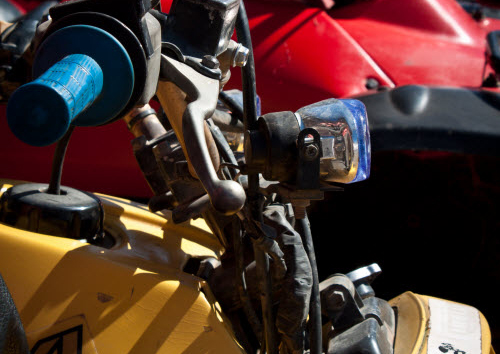|
ATV storage requires a little more time and forethought than simply putting your machine in the garage or shed when you’re finished for the season. But, if you’re willing to put the effort in, then your ATV will stay in better shape for much longer. Here are seven steps to winterizing an ATV before storing it away.
1. Cleaning
The best way to keep corrosion from developing on an ATV while it is in storage is to clean it thoroughly beforehand. Wash away any dirt, debris, bugs, or brake dust, and then rinse your ATV and allow it to dry. Protect the surfaces by spraying them with a polish and lubricate any parts that may corrode, like the chains, cables, lug nuts, sprockets, and exhaust pipes.

2. Coolant
Most ATVs need new coolant at least every two years, though you should consult your owner’s manual for your specific machine. If you’ve had the coolant changed recently enough, then there is nothing else you need to do. But, if your machine is due for a change, then you’ll need to flush the system and fill it back up with new coolant that has adequate antifreeze protection before storage.
3. Fuel
Leaving old fuel in the gas tank over the winter can lead to extensive corrosion and problems come spring. Avoid this by filling your tank up with fresh fuel and treating it with a fuel stabilizer. To ensure that the stabilizer gets distributed throughout the system, run your engine for at least five minutes, until it reaches operating temperatures.
4. Oil
Old and dirty oil can also cause damage to the internal components of your machine over the winter months and needs to be changed out. If you’ve recently had an oil change, then you likely don’t need to do it again right before storage. If not, then the best time to change the oil and oil filter on an ATV is while the engine is still warm after running the fuel stabilizer through.
5. Air filter
A dirty air filter can deteriorate and even cause corrosion if left over the winter. It’s best to check your filter and replace it now, if need be, both to keep up good maintenance habits and to save yourself the trouble in the spring.
6. Battery
It is highly recommended that you pull the battery from your ATV before winter to prevent it from losing its charge. Store the battery somewhere cool and dry, and keep it on top of a piece of insulating material like wood or plastic to avoid an accidental discharge.
7. Protection
Just before finally putting your ATV away, it is a good idea to block off the exhaust outlet and air intake to stop small rodents from nesting inside. Then, cover up your ATV with a tarp and you’re all finished. A breathable tarp is best for indoor storage, but you’ll need to use a waterproof tarp if keeping your ATV outside.
Winterizing your ATV is a great opportunity to perform some important yearly maintenance and make sure your machine is still in good working condition. By putting it away properly, you’ll be less likely to run into any problems in the spring that could keep you from hitting the trails.
|